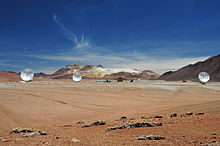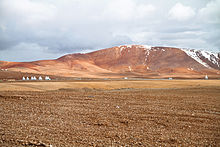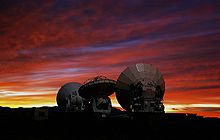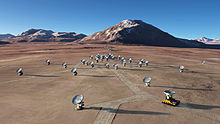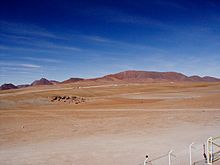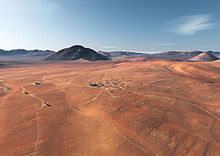- Atacama Large Millimeter Array
-
Atacama Large Millimeter/submillimeter Array 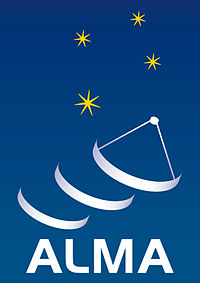 ALMA logo
ALMA logoOrganisation Multi-national Location Llano de Chajnantor Observatory
Atacama Desert, ChileCoordinates 23°01′9.42″S 67°45′11.44″W / 23.0192833°S 67.7531778°W Altitude 5,058.7 m (16597 ft) Telescope style at least 50 identical 12 m reflectors connected by fiber-optic cables Website Official ALMA site
Official NRAO ALMA site
Official ESO ALMA site
Official NAOJ ALMA siteThe Atacama Large Millimeter/sub-millimeter Array (ALMA) is an array of radio telescopes in the Atacama desert of northern Chile. Since a high and dry site is crucial to millimeter wavelength operations, the array is being constructed on the Chajnantor plateau at 5000 metres altitude. Consisting of 66 12-meter and 7-meter diameter radio telescopes observing at millimeter and sub-millimeter wavelengths, ALMA is expected to provide insight on star birth during the early universe and detailed imaging of local star and planet formation.
ALMA is an international partnership between Europe, North America, East Asia and the Republic of Chile. Costing more than a billion US dollars, it is the most expensive ground-based telescope currently under construction. ALMA began scientific observations in the second half of 2011 and the first images were released to the press on 3 October 2011. The project is scheduled to be fully operational by the end of 2012.
Contents
Overview
The initial ALMA array will be composed of 66 high-precision antennas, and operate at wavelengths of 0.3 to 9.6 mm. The array will have much higher sensitivity and higher resolution than existing sub-millimeter telescopes such as the single-dish James Clerk Maxwell Telescope or existing interferometer networks such as the Submillimeter Array or the Institut de Radio Astronomie Millimétrique (IRAM) Plateau de Bure facility.
The antennas can be moved across the desert plateau over distances from 150 m to 16 km, which will give ALMA a powerful variable "zoom", similar in its concept to that employed at the Very Large Array (VLA) site in New Mexico, US.
The high sensitivity is mainly achieved through the large numbers of telescopes that will make up the array.
The telescopes are provided by the European, North American and East Asian partners of ALMA. The American and European partners have each placed orders for twenty-five 12-metre diameter antennas, that will compose the main array. East Asia is contributing 16 antennas (four 12-metre diameter and twelve 7-metre diameter antennas) in the form of the Atacama Compact Array (ACA) which is also part of the enhanced ALMA.
By using smaller antennas than ALMA, larger fields of view can be imaged at a given frequency using ACA. Moving the antennas closer together will enable the imaging of sources of larger angular extent. The ACA will work together with the main array in order to enhance the latter's wide-field imaging capability.
History
ALMA has its conceptual roots in three astronomical projects: the Millimetre Array (MMA) of the United States, the Large Southern Array (LSA) of Europe, and the Large Millimetre Array (LMA) of Japan.
The first step toward the creation of what would become ALMA came in 1997, when the NRAO (National Radio Astronomy Observatory) and the ESO (European Southern Observatory) agreed to pursue a common project that merged the MMA and LSA. The merged array combined the sensitivity of the LSA with the frequency coverage and superior site of the MMA. ESO and NRAO worked together in technical, science, and management groups to define and organize a joint project between the two observatories with participation by Canada and Spain (the latter became a member of ESO later).
A series of resolutions and agreements led to the choice of "Atacama Large Millimeter Array", or ALMA, as the name of the new array in March 1999 and the signing of the ALMA Agreement on February 25, 2003, between the North American and European parties. Following mutual discussions over several years, the ALMA Project received a proposal from the NAOJ (National Astronomical Observatory of Japan) whereby Japan would provide the ACA (Atacama Compact Array) and three additional receiver bands for the large array, to form Enhanced ALMA. Further discussions between ALMA and NAOJ led to the signing of a high-level agreement on September 14, 2004, that makes Japan an official participant in Enhanced ALMA, to be known as the Atacama Large Millimeter/sub-millimeter Array.
During an early stage of the planning of ALMA, it was decided to employ ALMA antennas designed and constructed by known companies in North America, Europe and Japan rather than using one single design. This was mainly for political reasons. Although very different approaches have been chosen by the providers, each of the antenna designs appears to be able to meet ALMA's stringent requirements.
Funding
ALMA was initially a 50-50 collaboration between the US National Radio Astronomy Observatory and European Southern Observatory (ESO). The array has been extended with the help of the new Japanese, Taiwanese, and Chilean partners.[1] ALMA is the largest and most expensive ground-based astronomical project currently under construction (current cost estimate is US$1.3 billion).
- Partners
- European Southern Observatory and the European Regional Support Centre
- National Science Foundation via the National Radio Astronomy Observatory and the North American ALMA Science Center
- National Research Council of Canada
- National Astronomical Observatory of Japan (NAOJ) under the National Institutes of Natural Sciences (NINS)
- ALMA-Taiwan at the Academia Sinica Institute of Astronomy & Astrophysics (ASIAA)
- Republic of Chile
Assembly
The complex will be built primarily by European, U.S., Japanese and Canadian companies and universities. Three prototype antennae have undergone evaluation at the Very Large Array site in New Mexico since 2002.
General Dynamics C4 Systems has been contracted by Associated Universities, Inc. to provide twenty-five of the 12m antennae,[2] and European manufacturer Thales Alenia Space has been signed up to provide the other twenty-five principle antennae[3] (in the largest-ever European industrial contract). The first antenna was delivered in 2008, and the rest will be delivered at about one per month, finishing in 2011.
Transporting antennas to the site
Transporting the 115 tonne antennas from the Operations Support Facility at 2900 m altitude to the site at 5000 m presents enormous problems. The solution chosen is to use two custom 28-wheel self-loading heavy haulers. The vehicles are made by Scheuerle Fahrzeugfabrik in Germany and each is 10 m wide, 20 m long and 6 m high, weighing 130 tonnes. They are powered by twin 500 kW diesel engines.
The transporters, which feature a driver's seat designed to accommodate an oxygen tank to aid breathing the thin high-altitude air, can pick up the antennas and place them precisely at the site. The first vehicle was completed and tested in July 2007.[4] Both transporters were delivered to the ALMA Operations Support Facility (OSF) in Chile on February 15, 2008.
On July 7, 2008 an ALMA transporter for the first time moved an antenna, moving it from inside the antenna assembly building (Site Erection Facility) to a pad outside the building for testing (holographic surface measurements). The antenna was of the North American VertexRSI design.[5]
During Fall, 2009 the first three antennas were transported one by one to the Array Operations Site. At the end of 2009, a team of ALMA astronomers and engineers successfully linked three of the observatory's advanced antennas at the 16,500-foot (5,000 m)-elevation observing site thus finishing the first stage of assembly and integration of the fledgling array. Linking three antennas to work in unison for the first time allowed the ALMA team to correct errors that can arise when only two antennas are used, thus paving the way for precise, high-resolution imaging. With this key step, commissioning of the instrument began January 22, 2010.
On July 28, 2011, the first European antenna for ALMA arrived at the Chajnantor plateau, 5000 meters above sea level, to join antennas already in place from the other international partners, bringing the total number to 16. It is the number of antennas specified for ALMA to begin its first science observations, and is therefore an important milestone for the project.[6]
- Antenna Transport
Scientific results
Images from Initial Testing
 Antennae Galaxies composite of ESO/NAOJ/NRAO ALMA, VLA, CTIO, and Hubble observations.
Antennae Galaxies composite of ESO/NAOJ/NRAO ALMA, VLA, CTIO, and Hubble observations.
By the summer of 2011 sufficient telescopes were operational during the extensive program of testing prior to the Early Science phase for the first images to be captured. [7] These early images give a first glimpse of the potential of the new array that will produce much better quality images in the future as the scale of the array continues to increase.
The target of the observation was a pair of colliding galaxies with dramatically distorted shapes, known as the Antennae Galaxies. Although LMA did not observe the entire galaxy merger, the result is the best submillimeter-wavelength image ever made of the Antennae Galaxies, showing the clouds of dense cold gas from which new stars form, which cannot be seen using visible light.
Global collaboration
The Atacama Large Millimetre/sub-millimetre Array (ALMA), an international astronomy facility, is a partnership of Europe, North America and East Asia in cooperation with the Republic of Chile. ALMA is funded in Europe by the European Southern Observatory (ESO), in North America by the U.S. National Science Foundation (NSF) in cooperation with the National Research Council of Canada (NRC) and the National Science Council of Taiwan (NSC) and in East Asia by the National Institutes of Natural Sciences of Japan (NINS) in cooperation with the Academia Sinica (AS) in Taiwan. ALMA construction and operations are led on behalf of Europe by ESO, on behalf of North America by the National Radio Astronomy Observatory (NRAO), which is managed by Associated Universities, Inc (AUI) and on behalf of East Asia by the National Astronomical Observatory of Japan (NAOJ). The Joint ALMA Observatory (JAO) provides the unified leadership and management of the construction, commissioning and operation of ALMA.
ALMA regional centre (ARC)
The ALMA regional centre (ARC) has been designed as an interface between user communities of the major contributors of the ALMA project and the JAO. Activates for operating the ARC have also divided into the three main regions involved (Europe, North America and East Asia). The European ARC (led by ESO) has been further subdivided into ARC-nodes [8] located across Europe in Bonn-Bochum-Cologne, Bologna, Ondřejov, Onsala, IRAM (Grenoble), Leiden and JBCA (Manchester).
The core purpose of the ARC[9] is to: assist the user community with the preparation of observing proposals, ensure observing programs meet their scientific goals efficiently, run a help-desk for submitting proposals and observing programs, delivering the data to principal investigators, maintenance of the ALMA data archive, assistance with the calibration of data and providing user feedback.
Project detail
- At least 50 antennas of 12 m diameter located at an elevation of 5,000 m at Llano de Chajnantor Observatory, enhanced by a compact array of 4 x 12 m and 12 x 7 m antennas (consortium currently considering to build 50 or 64 [1][2])
- Imaging instrument in all atmospheric windows between 350 μm and 10 mm
- Array configurations from approximately 150 m to 14 km
- Spatial resolution of 10 milliarcseconds, 10 times better than the Very Large Array (VLA) and 5 times better than the Hubble Space Telescope
- The ability to image sources arcminutes to degrees across at one arcsecond resolution
- Velocity resolution under 50 m/s
- Faster and more flexible imaging instrument than the Very Large Array
- Largest and most sensitive instrument in the world at millimetre and sub-millimetre wavelengths
- Point source detection sensitivity 20 times better than the Very Large Array
- Data Reduction system will be CASA (Common Astronomy Software Applications) which is a new software package based on AIPS++
Project timeline
Timeline Date Activity 1995 ESO/NRAO/NAOJ joint site testing with Chile. May 1998 Start of Phase 1 (Design & Development). June 1999 European/U.S. Memorandum of Understanding for Design & Development. February 2003 Final European / North American Agreement, with 50% of funding from ESO, and 50% of funding shared between USA and Canada. April 2003 Testing of first prototype antenna begins at the ALMA Test Facility (ATF) site in Socorro, New Mexico. November 2003 Groundbreaking ceremony at ALMA site. September 2004 European, North American & Japanese draft agreement, with Japan providing new extensions to ALMA. October 2004 Opening of Joint ALMA office, Santiago, Chile. September 2005 Taiwan joins the ALMA Project through Japan. July 2006 European, North American & Japanese amend agreement on the Enhanced ALMA. April 2007 Arrival of first antenna in Chile. February 2008 Arrival of the two ALMA transporters in Chile. July 2008 First antenna movement with a transporter. December 2008 Acceptance of the first ALMA antenna. May 2009 First interferometry with two antennas at the Operations Support Facility (OSF). September 2009 First move of an ALMA antenna to Chajnantor. November 2009 Phase closure with three antennas at Chajnantor. 2010 Call for shared-risk Early Science proposals. Second semester 2011 Start of Early Science. End 2012 ALMA Inauguration. See also
- Atacama Pathfinder Experiment (APEX), single dish sub-millimetre telescope built on a modified ALMA prototype antenna
- Atacama Submillimeter Telescope Experiment
- CARMA a sensitive millimetre-wave array operated by a consortium including Caltech, University of California Berkeley, University of Illinois, University of Maryland and University of Chicago
- Cosmic Background Imager a 13 element interferometer operating in Llano de Chajnantor since 1999.
- IRAM 30 Meter Telescope (Pico Veleta, Spain), the largest millimetric telescope in the world, operated by IRAM
- James Clerk Maxwell Telescope The most sensitive existing sub-millimetre telescope
- Plateau de Bure Interferometer, one of the most successful existing millimetre-wave arrays, operated by IRAM
- List of observatories
References
- ^ ALMA Partners
- ^ GD - 2005
- ^ ESO - 2005
- ^ "Giant truck set for sky-high task." BBC News website, 30 July 2007. Retrieved 31 July 2007.
- ^ July 2008 NRAO ALMA newsletter article by Dr. Al Wootten
- ^ "European ALMA antenna brings total on Chajnantor to 16". ESO Organisation Release. 28 July 2011. http://www.eso.org/public/news/eso1127/. Retrieved 29 July 2011.
- ^ "ALMA Open its Eyes". ALMA Press Release. 3 October 2011. http://www.almaobservatory.org/en/press-room/press-releases/297-alma-opens-its-eyes. Retrieved 4 October 2011.
- ^ ARC-nodes
- ^ ALMA regional centre
External links
- Official ALMA site
- NRAO ALMA site
- UK ALMA site[dead link]
- ESO ALMA site
- ALMA site by NAOJ
- ALMA Antennas Collect First Data, "bbc.co.uk, 17 November 2009.
- Huge Observatory in Andes Takes Shape, Space.com, 7 February 2009.
European Southern Observatory Facilities 
Telescopes Telescope
instrumentsMiscellany Categories:- National Science Foundation
- Radio telescopes
- Submillimetre telescopes
- Interferometric telescopes
- Astronomical observatories in Chile
- European Southern Observatory
Wikimedia Foundation. 2010.


